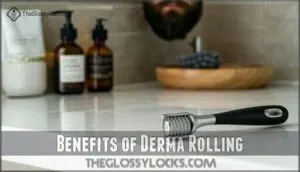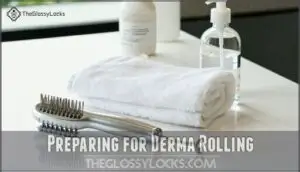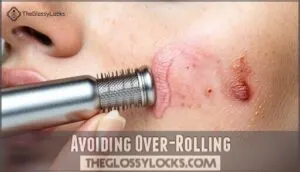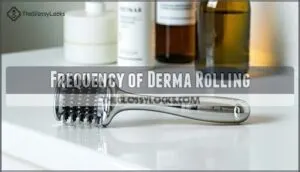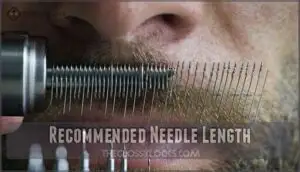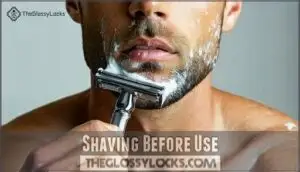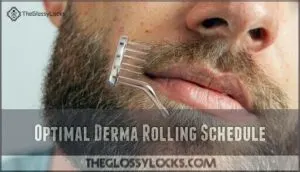This site is supported by our readers. We may earn a commission, at no cost to you, if you purchase through links.
 You’ll want to start your beard growth dermaroller routine at once per week, especially if you’re new to this skin-pricking business.
You’ll want to start your beard growth dermaroller routine at once per week, especially if you’re new to this skin-pricking business.
Think of it like training for a marathon – you wouldn’t sprint on day one. Begin with 0.25mm needles and give your face a full week to recover between sessions.
Your skin needs time to heal and rebuild collagen, which is where the real beard magic happens.
After 4-6 weeks, you can bump up the beard growth dermaroller frequency to twice weekly, then every other day as your skin toughens up.
However, larger needles require more recovery time, so patience pays off. The sweet spot balances consistency with proper healing.
Table Of Contents
- Key Takeaways
- Derma Roller Basics
- Benefits of Derma Rolling
- Preparing for Derma Rolling
- Derma Rolling Technique
- Frequency of Derma Rolling
- Derma Roller Size and Usage
- Preventing Side Effects
- Derma Roller and Beard Growth
- Optimal Derma Rolling Schedule
- Frequently Asked Questions (FAQs)
- How often should I derma roll for beard growth?
- Is dermaroller effective for beard growth?
- Can you overuse a beard roller?
- Is 25 or 5 derma roller for beard?
- Can derma rolling cause permanent skin damage?
- What products should be avoided after rolling?
- How long until visible beard growth results?
- Is derma rolling safe with beard implants?
- Can women use derma rollers for eyebrows?
- Conclusion
Key Takeaways
- Start slow and build tolerance – You’ll want to begin with once-weekly sessions using 0.25mm needles, then gradually increase to twice weekly after 4-6 weeks as your skin adapts and toughens up.
- Match frequency to needle size – You can use 0.25mm needles every other day, 0.5mm needles 1-3 times weekly for optimal beard growth, but larger needles require longer recovery periods between sessions.
- Don’t overdo it or you’ll damage your progress – Over-rolling causes irritation, scarring, and disrupts your skin’s natural healing process, which actually reduces the beard growth benefits you’re trying to achieve.
- Consistency beats intensity for real results – You’ll see the best beard growth improvements by sticking to a regular schedule for 3-6 months rather than trying to rush the process with more frequent sessions.
Derma Roller Basics
A derma roller is a handheld tool with tiny needles that creates microscopic wounds in your skin to trigger natural healing and collagen production.
This process stimulates blood flow to hair follicles and activates growth factors that encourage stronger, thicker beard growth over time, promoting natural healing.
What is a Derma Roller
A dermaroller is your pocket-sized microneedling device featuring tiny needles arranged on a cylindrical roller head.
The handle design allows easy maneuvering across your face, while the roller count typically includes eight rows of needles.
These needles, made from surgical-grade stainless steel, create microscopic punctures that trigger collagen and elastin production.
Proper sterilization methods keep your tool safe.
Alternative tools include derma pens, but rollers remain the most popular choice for beard growth.
How It Works for Beard Growth
When you roll those tiny needles across your facial skin, you’re creating controlled micro-wound damage that kickstarts your body’s repair system.
Tiny needles, big results—your skin’s repair system becomes your beard’s best friend.
This microneedling process triggers collagen stimulation and follicle activation around dormant hair roots.
The micro-injuries boost blood flow to nourish follicles while encouraging stem cell production.
Your skin responds by ramping up collagen production and releasing growth factors that promote beard growth stimulation through enhanced hair follicle stimulation.
Benefits of Derma Rolling
You’re probably wondering if dragging tiny needles across your face actually works for beard growth.
Derma rolling triggers your skin’s natural repair process, boosting collagen production, increasing blood flow to hair follicles, and helping beard oils absorb better into your skin, which includes improving the effectiveness of beard care products.
Stimulating Collagen Production
Your skin responds to micro-needling by ramping up collagen synthesis through fibroblast activation.
This process rebuilds the extracellular matrix, leading to scar reduction and improved skin elasticity.
Here’s how dermarolling beard growth works:
- Triggers cellular repair mechanisms
- Increases collagen production naturally
- Strengthens beard follicle foundation
- Enhances overall skin structure
This dermaroller benefits beard thickness increase substantially.
Improving Blood Circulation
Blood circulation acts as your beard’s lifeline, delivering essential nutrients and oxygen directly to hungry hair follicles.
When you dermaroll consistently—following proper beard dermaroller frequency guidelines—you’re boosting capillary health and enhancing nutrient delivery throughout your facial hair zone.
This improved oxygen supply accelerates waste removal while reducing inflammation, creating ideal conditions for robust dermarolling beard growth and stronger hair follicle stimulation, which relies on proper beard dermaroller frequency.
Enhancing Product Absorption
Microneedling opens tiny channels that act like highways for your topical products.
These microscopic pathways boost product penetration by up to 1000%, making your beard growth serums and oils work harder.
Enhanced hydration reaches deeper skin layers, while nutrient delivery improves dramatically.
Your dermaroller transforms expensive products from surface-level treatments into powerful, skin-penetrating solutions that actually reach hair follicles.
Preparing for Derma Rolling
Before you roll that derma roller across your face, proper preparation makes the difference between effective treatment and potential skin problems.
You’ll need to clean your tool, prep your skin, and choose the right needle size to guarantee safe and successful micro-needling sessions.
Cleaning The Derma Roller
Before each session, you’ll need to disinfect your derma roller properly.
Soak it in 70% isopropyl alcohol for at least 10 minutes – this alcohol concentration guarantees effective skin sterilization and infection prevention.
You can easily find isopropyl alcohol products online.
Use a disinfecting spray as backup, and store your clean roller in a dry case between uses to ensure maximum safety.
Replace every 3-4 months or when needles dull for maximum safety.
Preparing The Skin
Before diving into your dermaroller beard routine, proper skin preparation sets the foundation for success.
Start with beard trimming to prevent hair tangles, then complete thorough facial cleansing using warm water and gentle cleanser.
Confirm product readiness by having beard oils nearby, plus bleeding control supplies like clean towels.
This methodical approach maximizes your beard care routine effectiveness.
Choosing The Right Needle Size
Selecting the proper needle size determines your dermaroller success. Beginners should start with 0.25mm titanium needles to gauge pain tolerance and skin sensitivity while minimizing scarring potential.
Those comfortable with microneedling can progress to 0.5mm for enhanced product absorption and needle length benefits.
Exploring dermaroller needle options can help users make informed decisions. Consider your comfort level—shorter needles mean gentler sessions, while longer ones deliver more dramatic results.
Derma Rolling Technique
Once you’ve prepared your skin and derma roller, proper technique becomes essential for safe and effective results.
You’ll need to apply gentle pressure while rolling in systematic sections, ensuring you don’t overwork any area that could lead to irritation or damage, using gentle pressure.
Applying Light Pressure
Once your skin’s prepped, the key to effective dermaroller for beard success lies in your touch.
Think feather-light pressure – you’re not trying to puncture a tire. Your derma roller beard routine should feel like gentle tapping, not aggressive scrubbing.
Here’s your pressure checklist:
- Roll with barely-there contact – let the needles do their microneedling work naturally
- Stop if you feel pain – discomfort means you’re pressing too hard
- Maintain consistent pressure application throughout each pass for even results
Rolling in Sections
Once you’ve mastered pressure control, divide your beard area into manageable sections for systematic coverage.
Work methodically through each zone using horizontal, vertical, and diagonal rolling patterns.
Maintain consistent coverage by creating slight section overlap without double-rolling the same spot.
For longer beards, follow natural hair growth direction to prevent tangling.
This organized approach guarantees the best beard roller frequency results, ensuring a systematic and efficient process for optimal coverage.
Avoiding Over-Rolling
Understanding when to stop prevents serious skin damage and scarring risks.
You’ll notice irritation symptoms like excessive redness, burning, or bleeding if you’ve gone too far.
Stick to your planned beard roller frequency—typically once weekly for beginners.
Over-rolling disrupts the natural healing process and reduces product absorption, remembering that more isn’t always better in the context of microneedling beard frequency with your dermaroller.
Frequency of Derma Rolling
Getting your derma rolling frequency right makes the difference between healthy beard growth and skin irritation.
You’ll need to balance consistency with proper healing time, starting slow and adjusting based on your needle size and skin’s response, to achieve proper healing.
Starting With Weekly Sessions
When you’re new to dermaroller beard growth, start with weekly sessions to gauge your Initial Skin Response.
Choose a Beginner Needle Size like 0.25mm to minimize Discomfort Level while your skin adapts.
This approach helps manage Initial Expectations—you won’t see dramatic dermaroller beard results immediately, but consistent microneedling beard frequency builds the foundation for effective beard growth dermaroller treatment without overwhelming your skin.
Increasing Frequency Gradually
Your tolerance building journey with dermaroller microneedling requires patience and careful skin adjustment.
Start with once-weekly sessions, then monitor results for 2-3 weeks before considering frequency increases.
- Week 1-3: Establish baseline tolerance with weekly dermaroller sessions
- Week 4-6: Assess individual response and gradual progression needs
- Week 7+: Consider twice-weekly microneedling beard frequency if skin adapts
- Monitor continuously: Track beard growth dermaroller results and skin reactions
Avoiding Overuse
The temptation to dermaroll daily can backfire spectacularly.
Overusing your dermaroller creates excessive skin irritation and scarring risk that’ll set back your beard growth goals.
Your skin needs proper healing time between sessions – ignore this and you’ll face uncomfortable discomfort levels plus potential skin damage.
Stick to recommended derma roller frequency guidelines to avoid turning your face into a battlefield and ensure you don’t cause excessive skin irritation.
Needle Size for Beginners
Starting your dermaroller journey requires choosing the right needle size to match your pain threshold and skin sensitivity.
Beginners should prioritize safety over initial results to minimize infection risk while learning proper technique.
Here’s your beginner-friendly approach:
- 0.25mm needles – Perfect for sensitive skin and first-time users
- 0.5mm needles – Ideal balance of effectiveness and comfort for most beginners
- Avoid 0.75mm+ – Too aggressive for inexperienced microneedling users
Needle Size for Beard Growth
For ideal beard growth, you’ll want a 0.5mm needle length guide that balances effectiveness with safety.
This penetration depth stimulates collagen production without exceeding most people’s pain tolerance or increasing scarring risk.
The 0.5mm ideal size works perfectly for microneedling facial hair areas.
Your beard growth roller should create micro-channels while keeping discomfort minimal during sessions, ensuring a safe and effective way to promote beard growth.
Needle Size for Sensitive Skin
If you’ve got sensitive skin, your dermaroller needle size selection becomes even more critical.
Choose 0.2mm to 0.3mm needles to minimize skin irritation while still getting benefits.
These shorter needles reduce redness duration and respect your pain thresholds.
This Needle Length Guide approach prevents product sensitivity reactions.
Start with microneedling sessions spaced further apart for ideal irritation prevention.
Derma Roller Size and Usage
Choosing the right needle size makes all the difference between effective beard growth stimulation and potential skin damage.
You’ll want to match your derma roller’s needle length to your experience level and skin sensitivity, with beginners starting at 0.25mm and working up to 0.5mm for ideal results.
Recommended Needle Length
Choosing the right needle length for your dermaroller makes all the difference between effective microneedling and potential skin irritation.
For beard growth, 0.25mm to 0.5mm works best—0.25mm suits beginners with high skin sensitivity, while 0.5mm delivers better product absorption for sparse areas.
Consider your pain threshold and scarring potential when selecting from any needle size chart.
You can also find products related to dermaroller needle length.
Shaving Before Use
Clean-shaven skin creates the perfect canvas for your dermaroller session.
Trimming or shaving removes hair barriers that block needle penetration and prevent even microneedling coverage across your beard area.
Shaving Benefits for dermaroller effectiveness:
- Enhanced Product Penetration – Removes hair obstacles for deeper serum absorption
- Reduced Skin Irritation – Prevents needle snagging and uncomfortable pulling sensations
- Minimized Ingrown Hairs – Clears follicle openings before microneedling stimulation
- Optimal Hair Length – Guarantees direct skin contact for maximum beard growth stimulation
Consulting a Dermatologist
Before starting your beard growth journey, seeking professional advice sets you up for success.
A dermatologist provides expert recommendations through proper skin assessment, helping you avoid potential risks while establishing realistic expectations for your personalized regimen.
| Consultation Benefits | What They Assess | Recommended Actions |
|---|---|---|
| Skin type evaluation | Sensitivity levels | Custom needle sizes |
| Risk factor identification | Existing conditions | Safe frequency schedules |
| Treatment customization | Individual goals | Product recommendations |
| Progress monitoring | Results tracking | Regimen adjustments |
Dermatology professionals understand beard growth patterns better than generic online guides.
Preventing Side Effects
You’ll want to follow proper safety guidelines when derma rolling to avoid unnecessary irritation, infection, or skin damage.
Understanding these key precautions helps you maintain healthy skin while maximizing your beard growth results.
Avoiding Sensitive Areas
Your dermaroller can work wonders for beard growth, but certain areas are off-limits.
Skip the eye area and lips entirely – these zones have heightened skin sensitivity that can’t handle microneedling.
Never roll over active acne, healing wounds, or cracked skin, as this spreads bacteria and delays recovery.
- Eye Area: Too delicate for any needle length – risk permanent damage
- Active Acne: Rolling spreads infection and worsens breakouts substantially
- Healing Wounds: Disrupts natural recovery process and increases scarring risk
- Lip Sensitivity: Thin skin tears easily, causing unnecessary pain and swelling
Avoiding Twisting or Scraping
Never twist your dermaroller while it’s touching your skin – this creates painful scratches instead of clean micro-channels.
Keep the roller angle perpendicular to your face and lift it completely before changing direction.
Gentle pressure with proper technique prevents skin damage and guarantees effective microneedling for beard growth.
| Wrong Technique | Correct Method | Result |
|---|---|---|
| Twisting on skin | Lift between directions | Clean punctures |
| Scraping motions | Straight rolling only | No irritation |
| Diagonal dragging | Perpendicular contact | Even penetration |
| Heavy pressure | Light, consistent touch | Minimal trauma |
| Quick movements | Slow, controlled rolls | Better absorption |
Allowing Healing Time
Your skin needs proper recovery time between dermaroller sessions to heal effectively. Microwounds from microneedling require 48-72 hours to close completely, and rushing this process leads to irritation and scarring. Individual variation affects healing stages—some recover faster than others.
Watch for recovery signs like reduced redness before your next session.
- Your beard dreams crumble when over-rolling risks damage your precious follicles
- That burning regret hits hard when you realize you’ve set back months of progress
- Victory feels sweet when patience pays off with thick, healthy growth
How often dermaroll beard depends on your skin’s healing capacity and product absorption needs.
Derma Roller and Beard Growth
Your derma roller works by creating tiny wounds in your skin that trigger your body’s natural healing response, which boosts blood flow and activates growth factors essential for beard development.
This process encourages dormant hair follicles to wake up and start producing thicker, stronger facial hair while improving the overall health of your skin underneath.
Stimulating Hair Growth
Once you’ve mastered safe dermaroller technique, you’re ready to tap into its hair-stimulating power.
The micro-wounds trigger follicle reactivation by awakening dormant hair follicles beneath your skin.
This process activates stem cells and enhances gene expression patterns that promote beard growth.
When you dermaroll your beard consistently, you’ll notice improved beard density as previously inactive hair follicles begin producing stronger, thicker facial hair.
Increasing Blood Flow
Rolling your dermaroller creates tiny wounds that kickstart your body’s repair mode.
This microneedling process dramatically improves blood circulation around each hair follicle, delivering fresh nutrients and oxygen directly where you need it most.
Here’s how enhanced circulation transforms your beard growth:
- Capillary Stimulation – Opens new pathways for nutrient delivery
- Oxygen Supply – Feeds follicles for ideal growth conditions
- Waste Removal – Clears toxins that block healthy development
Boosting Growth Factors
Each micro-puncture from your dermaroller acts like a biological wake-up call, triggering stem cell activation around dormant follicles.
Wake up those sleeping follicles – your dermaroller is the alarm clock your beard has been waiting for.
This process enhances gene expression for hair growth while boosting nutrient delivery to struggling areas.
When combined with minoxidil synergies, follicle reactivation becomes more pronounced, benefiting from this collagen stimulation and improved blood circulation supporting hair follicle health, which ultimately enhances your beard growth.
Optimal Derma Rolling Schedule
Your derma rolling schedule depends entirely on your needle size, with smaller needles allowing more frequent use while larger ones require extended recovery periods.
Getting this timing right prevents skin irritation and maximizes beard growth results, since your skin needs adequate healing time between sessions to build collagen and stimulate hair follicles effectively to achieve optimal collagen production.
Frequency Based on Needle Size
Beyond the basics, your dermaroller needle size directly dictates how often you can safely roll. Larger needles create deeper wounds that need more recovery time, while smaller ones allow frequent use.
Here’s your frequency guide based on needle size effects:
- 0.25mm needles: Every other day for gentle stimulation
- 0.5mm needles: 1-3 times weekly for ideal beard growth
- 1.0mm needles: Once every 10-14 days maximum
- 1.5mm needles: Monthly sessions only
- Individual skin response: Adjust based on healing timeframes
Allowing Skin Recovery Time
Your skin needs time to bounce back after dermarolling sessions.
Healing Timeframes vary by needle length – shorter needles require 24-48 hours while longer ones need up to two weeks.
Rushing into Over-Rolling Risks irritation and compromises Collagen Synthesis.
Watch for persistent Redness Management issues, which signal inadequate skin repair time.
Proper skin healing prevents Scar Prevention problems and maximizes your dermaroller’s effectiveness.
Maintaining Consistent Results
Sticking to your dermarolling frequency pays off in the long run. Your beard growth routine needs patience and discipline to see real results over months, not weeks.
For lasting beard growth stimulation, maintain these habits:
- Consistent Technique – Same pressure and pattern every session
- Regular Schedule – Never skip your planned dermarolling days
- Proper Hygiene – Clean tools prevent setbacks from infections
- Gradual Progression – Increase intensity slowly over time
- Realistic Expectations – Results take 3-6 months of dedicated beard maintenance
Frequently Asked Questions (FAQs)
How often should I derma roll for beard growth?
You should derma roll once every 7-10 days for ideal beard growth.
This frequency allows your skin to heal properly while maintaining consistent collagen stimulation.
Start weekly, then adjust based on your skin’s response.
Is dermaroller effective for beard growth?
Yes, dermarollers can effectively stimulate beard growth by creating micro-injuries that trigger your skin’s healing response. This increases blood flow and collagen production, potentially reactivating dormant follicles for thicker growth.
Can you overuse a beard roller?
Like watering a plant daily can drown it, you’ll damage your skin if you derma roll too frequently.
Yes, overuse causes irritation, scarring, and prevents proper healing.
Stick to once weekly for best results.
Is 25 or 5 derma roller for beard?
For beginners, choose 25mm needles—they’re gentler and can be used every other day.
If you want stronger results and have some experience, go with 5mm needles, but limit use to 1-3 times weekly.
Can derma rolling cause permanent skin damage?
Walking through a minefield of misinformation, you’ll find proper derma rolling rarely causes permanent damage.
However, excessive pressure, dirty needles, or overuse can lead to scarring, infections, and lasting skin issues you’ll regret.
What products should be avoided after rolling?
Avoid harsh chemicals, alcohol-based products, retinoids, and exfoliating acids after derma rolling.
Skip fragrances, essential oils, and active ingredients like glycolic acid.
You’ll want gentle, soothing products instead to prevent irritation and infection.
How long until visible beard growth results?
Studies show 82% of users see improvements within 12 weeks when combining derma rolling with growth products.
You’ll typically notice initial changes around 6-8 weeks, with more significant beard density appearing after 3-4 months of consistent use.
Is derma rolling safe with beard implants?
You’ll need to wait at least 6-12 months after beard implant surgery before using a derma roller.
Consult your surgeon first, as the grafts need time to fully heal and establish proper blood supply.
Can women use derma rollers for eyebrows?
Yes, you can use derma rollers for eyebrow growth.
Choose 25mm needles and roll gently once weekly.
The micro-needling stimulates blood flow and follicles, potentially encouraging thicker brow growth when combined with growth serums.
Conclusion
Mastering beard growth dermaroller frequency isn’t rocket science, but it requires discipline and patience.
Start with weekly 0.25mm sessions, gradually increasing to twice weekly after your skin adapts.
Remember, consistency beats intensity every time, and your beard growth dermaroller frequency should balance stimulation with proper healing time.
Stick to the schedule, avoid overuse, and you’ll see significant improvements in beard density and growth, so trust the process – your future bearded self will thank you.

